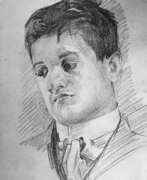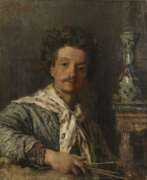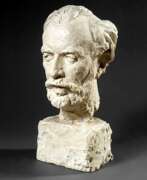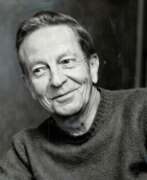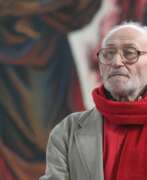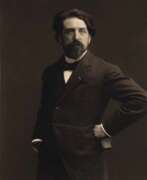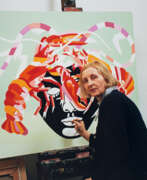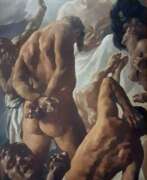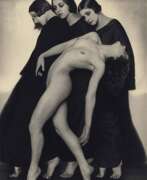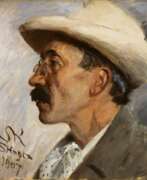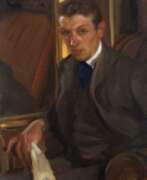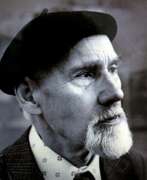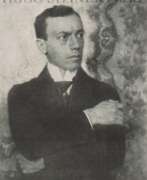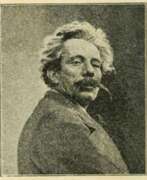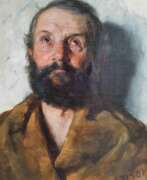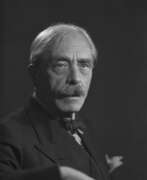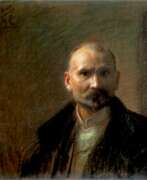Educators Symbolism


Jan Ciągliński (Russian: Ян Францевич Ционглинский), a Polish Impressionist painter established in Russia, was born into a noble family in Warsaw on February 20, 1858, and died on January 6, 1913, in Saint Petersburg. He studied at the University of Warsaw before moving to Saint Petersburg in 1879, where he furthered his education at the Imperial Academy of Arts. Ciągliński was a pivotal figure in the Russian art scene, recognized as one of the first Russian Impressionists. His success in Russia was significant, though he remained less known in his native Poland.
Ciągliński's art was inspired by his travels across Europe, North Africa, and the Middle East, painting landscapes, often with oriental themes, symbolic images, figure compositions, decorations, and portraits. He was celebrated for his color work and the way he captured light. Among his notable students were Ivan Bilibin, Viktor Vesnine, Mikhail Matiushin, Pavel Filonov, and Yelena Guro, highlighting his influential role as an educator. Ciągliński was also one of the founders of "Mir Iskusstva" (World of Art), contributing significantly to its development.
Some of Ciągliński's works can be found in museums across Poland and Ukraine, a testament to his last will to donate his oeuvre to his homeland. His legacy is reflected in his diverse body of work that includes portraits of famous musicians such as Pyotr Tchaikovsky, Sergei Rachmaninoff, and Frederic Chopin, showcasing his connection to the music world.
For collectors and art and antiques experts interested in the intersection of Polish heritage and Russian Impressionism, Jan Ciągliński's work represents a fascinating study. Sign up for updates on new product sales and auction events related to Jan Ciągliński to explore more about this distinguished artist's contributions to the art world.
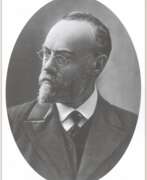

Nikolay Nikanorovich Dubovskoy (Russian: Николай Никанорович Дубовской) was a distinguished Russian landscape painter, renowned for his significant contributions to the "Landscape of Mood" movement alongside Isaac Levitan. Born into a Don Cossack family in Novocherkassk in 1859, Dubovskoy demonstrated artistic talent from an early age, initially encouraged by his uncle A.V. Pyshkin. Despite his father's initial insistence on a military career, Dubovskoy pursued his passion for art, studying under Mikhail Clodt at the Imperial Academy of Arts and later refusing a conventional academic path to instead exhibit with the Imperial Society for the Encouragement of the Arts. His work, "Winter," gained him early recognition when acquired by the Tretyakov Gallery in 1884.
Dubovskoy's legacy includes several masterpieces, such as "After the Rain," a beautiful example of his mature period that demonstrates the influence of French Impressionism, with its open composition and luminous treatment of light. This piece and others underline his mastery in capturing the nuanced interplay of light and atmosphere, resonating with both the Impressionist and Itinerant movements. Unfortunately, the distribution of his works across various museums after his death and the Soviet Union's collapse has made accessing his complete oeuvre challenging, requiring a journey across multiple countries.
Dubovskoy's contributions to Russian landscape painting and his unique ability to evoke mood and atmosphere in his works have cemented his place among the greats of the art world. His paintings, such as "The Calm Evening," praised as a "poem in gold" by critics, demonstrate his exceptional skill in rendering the delicate interplay of light and color. For those interested in exploring the depths of Russian landscape painting, Nikolay Nikanorovich Dubovskoy's works offer a rich and emotive experience, embodying the spirit of an era and the beauty of the Russian landscape.
To stay updated on sales and auction events featuring works by Nikolay Nikanorovich Dubovskoy, sign up for our updates. This subscription will ensure you're informed about new opportunities to appreciate and acquire pieces by this illustrious artist, focusing solely on relevant product sales and auction events.
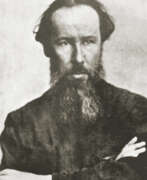

Vladimir Andreyevich Favorsky (Russian: Владимир Андреевич Фаворский) was a distinguished Russian artist and educator, renowned for his profound contributions to the realms of printmaking, illustration, and theory of art. Born into a milieu rich in culture and intellectual pursuit, Favorsky's work transcended the conventional boundaries of art, integrating elements of sculpture, painting, and graphic design, thereby redefining the aesthetic parameters of his time.
Favorsky's artistic philosophy was grounded in the belief that art should be a reflection of reality, yet imbued with the artist's personal vision and inner world. This approach led him to explore various mediums, yet he is most celebrated for his woodcuts and book illustrations. His ability to blend classical techniques with innovative narratives made his works timeless, appealing to collectors and art enthusiasts alike. Favorsky's contributions were not confined to his own creations; as a revered educator at the Moscow Printing Institute, he influenced generations of artists, instilling in them a deep appreciation for the cultural and historical significance of art.
Among his notable works, Favorsky's illustrations for classics of Russian literature stand out, capturing the essence of the narratives with striking visual imagery. While specific pieces in museums or galleries could not be verified without current research, his influence permeates the Russian art scene, with his works held in high esteem by collectors around the globe.
For collectors and experts in art and antiques, Favorsky's oeuvre represents a bridge between traditional and modern artistic expressions, offering a rich tapestry of themes and techniques to explore. His legacy continues to inspire, serving as a testament to the enduring power of artistic innovation and vision.
For enthusiasts eager to delve deeper into Favorsky's world, we invite you to sign up for updates. This subscription ensures you're the first to know about new product sales and auction events related to Vladimir Andreyevich Favorsky, without overwhelming your inbox. Embrace the opportunity to enhance your collection with pieces from a master of Russian art and culture.
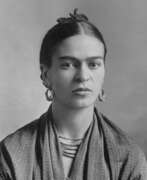

Frida Kahlo de Rivera was a Mexican painter, renowned for her captivating self-portraits that blend realism and fantasy. Born Magdalena Carmen Frida Kahlo y Calderón on July 6, 1907, in Coyoacán, Mexico City, she is celebrated for her profound exploration of identity, postcolonialism, gender, and class within Mexican society. Kahlo's works are a fusion of naïve folk art style and surreal elements, deeply influenced by Mexican popular culture and her personal experiences of chronic pain and disability.
Despite facing numerous challenges, including polio in her childhood and a catastrophic bus accident at 18, Kahlo's resilience and passion for art were undeterred. Her marriage to the famous Mexican artist Diego Rivera was both a romantic and artistic alliance. Kahlo's paintings, such as "The Two Fridas" (1939) and "Self-Portrait with Thorn Necklace and Hummingbird" (1940), are not only masterpieces of visual art but also compelling narratives of her life's trials and triumphs.
Kahlo's artistry extended beyond the canvas, as she was actively involved in the Mexican Communist Party, and her home, La Casa Azul, is now the Frida Kahlo Museum, a place of homage for her admirers. Although her work was not as widely recognized during her lifetime, Kahlo's legacy has grown tremendously, making her an icon for various social movements and a beacon in the art world.
For collectors and art experts, the journey into Kahlo's world is both a dive into Mexican cultural heritage and an exploration of the profound human experience. If you're passionate about Frida Kahlo's work and want to stay informed about related product sales and auction events, sign up for our updates. This is not just a subscription; it's an invitation to celebrate and own a piece of art history.
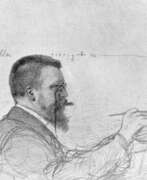

Ferdinand Keller was a German painter of the last third of the nineteenth and early twentieth centuries. He is known as a genre and historical painter as well as a teacher.
Keller earned his first major success in 1867 with his painting The Death of King Philip II of Spain. In his monumental works, he celebrated historical, dynastic, and cultural episodes in the history of Germany and Baden. One of his famous works is the painting "Apotheosis of Kaiser Wilhelm I", which was purchased by Kaiser Wilhelm II. Keller's works now grace the halls of theaters including the Baden State Theater and the Semper Opera in Dresden.
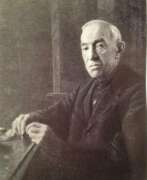

Nikolaу Petrovich Krymov (Russian: Никола́й Петро́вич Кры́мов), born on May 2, 1884, in Moscow, Russia, was a renowned Russian and Soviet painter and art theoretician, celebrated for his contributions to landscape painting and art education. Krymov hailed from an artistic family, and his education in the arts was comprehensive, studying under prominent figures like Abram Arkhipov, Nikolay Kasatkin, Leonid Pasternak, Valentin Serov, and Konstantin Korovin at the Moscow School of Painting, Sculpture and Architecture. His artistic journey began with participation in student exhibitions in 1906, and his works were soon featured in major exhibitions, including those of the Blue Rose, the Golden Fleece, and the Union of Russian Artists, marking his integration into significant artistic circles of his time.
Krymov's early works were significantly influenced by Isaac Levitan's delicate vision of Russian nature, focusing on the subtleties of daily transitions and the beauty of the Russian countryside. This influence is evident in Krymov's ability to convey the ethereal qualities of light and atmosphere in his landscapes, which were appreciated for their emotional depth and technical prowess. Among his notable works are paintings like "Dawn" (1908), "On the Mill" (1915), "First Snow" (1917), and "Hot Day" (1920), all of which demonstrate his masterful handling of light, shadow, and composition to capture the essence of nature.
Krymov's career also included significant contributions to art education and theory. He was an active participant in the "Blue Rose" movement, where he explored symbolism and impressionism, later transitioning towards a more classical approach in his landscapes. This evolution in style reflected his continuous search for an ideal harmony between reality and fantasy in his works. His dedication to art was recognized with several honors, including the title of Honorary Art Worker of the Russian Federation and the prestigious Order of the Red Banner of Labour.
Krymov's legacy extends beyond his paintings to include his influence on future generations of artists through his teaching and theoretical writings. His works are housed in museums and private collections, where they continue to be celebrated for their contribution to the landscape genre and Russian art.
For art collectors and experts interested in the rich tapestry of Russian landscape painting, Krymov's works offer a window into the soul of Russian nature and the artistic movements of the early 20th century. To stay updated on new product sales and auction events related to Nikolay Petrovich Krymov, signing up for updates is highly recommended. This subscription ensures that enthusiasts and collectors alike are informed about opportunities to acquire pieces by this illustrious artist, celebrating his enduring influence on the world of art.
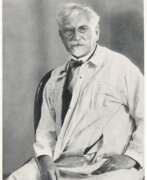

Alfons Maria Mucha, a Czech Art Nouveau painter and decorative artist, was celebrated for his innovative contributions to art, particularly his distinctive style that became synonymous with the Art Nouveau movement. Born in 1860 in the Moravian town of Ivancice, Mucha exhibited artistic talent from a young age, initially showing a proclivity for drawing and music, which were closely intertwined in his perception of creative expression. Despite early financial and educational hurdles, Mucha's passion for art led him to Vienna and subsequently Munich, where he honed his skills and absorbed influences that would shape his future work.
Mucha's career took a pivotal turn in Paris, where his poster for the actress Sarah Bernhardt's play "Gismonda" gained him immediate fame. This partnership with Bernhardt catalyzed a prolific period during which Mucha produced a flurry of artworks, including paintings, posters, and illustrations, as well as designs for jewelry, wallpaper, and theatre sets. His works are characterized by their depiction of beautiful young women in flowing robes, surrounded by lush, natural elements and often featuring pastel colors—a stark contrast to the bold hues preferred by his contemporaries.
Despite his commercial success, Mucha aspired for his art to convey a deeper spiritual message rather than merely adhering to the trendy Art Nouveau style. This led him to undertake projects that were more personal and culturally significant, such as "The Slav Epic"—a series of paintings celebrating Slavic history. Mucha's legacy is not only preserved in his diverse body of work but also in his influence on the aesthetic values of craftsmanship and design.
Collectors and experts in art and antiques continue to venerate Mucha for his unique ability to blend artistic beauty with cultural expression. His works, which are housed in museums and galleries worldwide, remain a testament to his vision and creativity.
For those keen on exploring the world of Alfons Maria Mucha further and staying updated on new sales and auction events related to his work, signing up for updates is an excellent way to ensure you never miss an opportunity to appreciate or acquire pieces related to this iconic artist. This subscription is tailored for collectors and art enthusiasts, focusing solely on new product sales and auction events concerning Mucha's legacy.
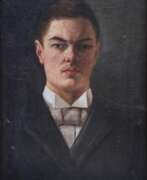

Kuzma Sergeyevich Petrov-Vodkin (Russian: Кузьма Сергеевич Петров-Водкин), a Russian painter, synthesized various traditions of global art, crafting a unique and deeply personal visual language. Born in 1878 in Khvalynsk, Saratov oblast, Russian Empire, Petrov-Vodkin is celebrated for his innovative approach to perspective, color, and composition, which positioned him as a pivotal figure in the art world of his time. He passed away in 1939 in Leningrad, now known as St. Petersburg, Russia.
Petrov-Vodkin's education in the arts took him from the Baron Stieglits School in Saint Petersburg to the Moscow School of Painting, Sculpture, and Architecture, where he was mentored by notable artists such as Valentin Serov. His studies abroad, including in Munich under Anton Ažbe, further enriched his artistic development. Notably, his marriage to Maria Jovanovic in Paris in 1906 marked a significant personal chapter, providing him with a lifelong companion and collaborator.
His work is distinguished by the use of "spherical perspective," a technique that distorts the drawing to emphasize the globe's curvature, making the viewer feel simultaneously distant and intimately close to the subject. This method, influenced by Byzantine iconography's inverted perspective, is evident in works like "Death of a Commissar" and "In the Line of Fire." Petrov-Vodkin's palette darkened over time, and his subjects diversified to include still life and portraiture, reflecting a broader exploration of theme and form. Despite facing health challenges, including pulmonary tuberculosis which limited his painting in later years, he remained prolific in other creative avenues, including literature, where his semi-autobiographical works are held in high regard.
His legacy is enshrined in the Russian Museum in St. Petersburg, which houses the largest collection of his works and dedicates a room to his art in their permanent exhibition. Additionally, a memorial museum in his hometown of Khvalynsk pays tribute to his contributions to Russian and Soviet art.
For collectors and art and antiques experts intrigued by Petrov-Vodkin's profound impact on Russian art, signing up for updates can ensure access to the latest sales and auction events related to his oeuvre. This subscription is a gateway to exploring the depth and breadth of Petrov-Vodkin's artistic achievements and ensuring enthusiasts are well-informed of opportunities to engage with his work.
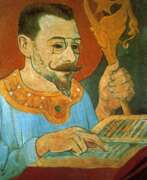

Paul-Élie Ranson, a French painter and writer, emerged as a prominent figure in the late 19th century art scene. Born in Limoges, he was raised by his grandparents and father after his mother's demise during childbirth. Ranson's early artistic inclinations were nurtured with drawing lessons from his grandfather. His educational journey in the arts began at the École des Beaux-Arts Appliqués à l'Industrie and later continued at the Académie Julian in Paris.
Ranson was a pivotal member of "Les Nabis," a group instrumental in transitioning from Impressionism to modern art. Along with notable contemporaries like Paul Sérusier, Pierre Bonnard, and Maurice Denis, he helped establish an art movement that blended elements of Symbolism, Art Nouveau, and Japanese prints. Ranson's role extended beyond painting; he was actively involved in the Symbolist performances at the Théâtre d'Art and directed a notable performance of "Ubu Roi" by Alfred Jarry.
Ranson's artistic oeuvre is marked by a fascination with Theosophy, magic, and occultism, themes that increasingly influenced his work. His paintings often delved into mythology, witchcraft, and anti-clerical subjects. Some of his notable works include "Christ and Buddha" (1880), "Witches Around the Fire" (1891), and "The Blue Room" (circa 1900). These works exemplify his unique blend of thematic and stylistic elements, setting him apart from his contemporaries.
Tragically, Ranson's life was cut short by typhoid fever in 1909. However, his legacy continued through the Académie Ranson, founded by his friends in Les Nabis. This institution, managed initially by Ranson and later by his wife Marie, remained active until 1955, perpetuating his influence on future generations of artists.
For art collectors and experts, Ranson's work offers a unique window into the transitionary period of late 19th-century art, showcasing the interplay of traditional and emerging styles. His contributions to the Symbolist and Nabi movements are particularly noteworthy.
To stay updated on new product sales and auction events related to Paul-Élie Ranson, sign up for our updates. This subscription service is tailored to keep art aficionados informed about the latest developments and opportunities related to Ranson's art.
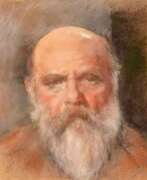

Ker-Xavier Roussel was a French painter, renowned for his distinctive post-impressionist style and his affiliation with the Nabis, an avant-garde artist group. Born in 1867, Roussel's artistic journey began in his teens and continued robustly into the 20th century, leaving a legacy celebrated for its mythological and bucolic themes.
Roussel's art is characterized by its vivid portrayal of mythological scenes and landscapes, often infused with a sense of eroticism and joy. His work frequently depicts Greek myths set against the backdrop of the Mediterranean, featuring figures like women, nymphs, centaurs, and fauns. These large, brightly colored paintings, such as "Rural Festival, Summer" and "The Seasons of Life," marked a departure from the smaller formats typical of the Nabis, showcasing his evolution towards a more expansive and expressive style.
A master of pastels, Roussel's work from the 1890s, such as "La Barrière," displayed at the Musée d'Orsay, reflects the Nabi style with its Japanese print influences, absence of perspective, and contrasting values. His later works, created between 1930 and 1944, often depicted violent mythological deaths, revealing a darker aspect of his artistic expression.
Roussel's contributions extended beyond canvas, as he created large paintings for public spaces and private clients, including a significant panel for the Palais des Nations in Geneva and the front curtain of the Théâtre des Champs-Élysées. His recognition peaked in the 1930s, with a multi-panel scheme for the Palais de Chaillot and winning the Carnegie Prize for art in 1926.
Despite a period of obscurity, Roussel's work regained attention through exhibitions like "Ker-Xavier Roussel, Private Garden, Dreamed Garden" at the Musée des Impressionnismes in Giverny, showcasing his significant contributions to art history.
For art collectors and experts, understanding Roussel's work offers insights into the evolution of post-impressionism and the Nabis' influence on modern art. His unique blend of mythological themes and vibrant landscapes represents an important chapter in art history. For those interested in exploring Roussel's work further or keeping updated on related art sales and auctions, signing up for updates is a valuable opportunity to deepen your engagement with this influential artist's legacy.
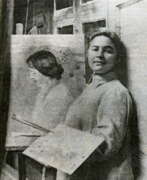

Nadezhda Savelyevna Voitinskaya-Levidova (Russian: Надежда Савельевна Войтинская-Левидова) was a multifaceted Russian artist, writer, and translator, whose life spanned from 1886 to 1965. Born into a family with a strong academic background in St. Petersburg, she carved a unique path for herself in the arts and literature. Voitinskaya-Levidova was not only known for her artistic talents but also for her resilience and adaptability through challenging times, including her wrongful arrest in 1938 and survival during the siege of Leningrad in World War II.
Her journey into the arts began with painting lessons in private studios in St. Petersburg, followed by studies in painting and lithography in Paris. Voitinskaya-Levidova's return to Petersburg marked the beginning of a prolific period where she became closely associated with the "World of Art" artists. She made significant contributions through a series of lithographic portraits of famous writers of her time in 1909, demonstrating her skill and versatility in graphic arts. Her academic achievements included graduating from the Petrograd Institute of Art History in 1924, after which she dedicated herself to teaching and translating, enriching the cultural landscape with her translations of works by European authors and her own literary works.
The legacy of Nadezhda Savelyevna Voitinskaya-Levidova is preserved in the archives of Russia's National Library and her artworks, many of which are housed in prestigious collections such as the State Russian Museum, the Tretyakov Gallery, and the Pushkin Museum of Fine Arts. Her life and work stand as a testament to her enduring spirit and significant contributions to Russian art and literature.
For collectors and experts in art and antiques, the story of Nadezhda Savelyevna Voitinskaya-Levidova is a compelling narrative of creativity, resilience, and the power of cultural expression. Her contributions to art and literature continue to inspire and resonate with audiences, underscoring the importance of preserving and celebrating her legacy.
To stay updated on exhibitions and sales related to Nadezhda Savelyevna Voitinskaya-Levidova's work, consider signing up for updates. This subscription ensures you're informed about new product sales and auction events specifically related to her oeuvre, connecting you directly with the rich history and enduring impact of her contributions to art and culture.
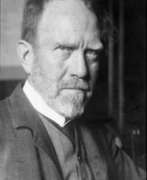

Carl von Marr was an American-born German painter of the late nineteenth and first third of the twentieth centuries. He is known as a painter and teacher, a professor at the Munich Academy of Fine Arts.
Carl von Marr worked in religious, mythological, and domestic genres, and also painted portraits. He received gold medals in Germany and the United States, where his works were exhibited. The master was a member of the board of directors of the German Artists Association.
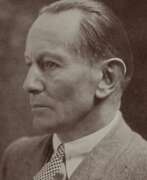

Emil Rudolf Weiss was a German painter, typographer, graphic designer and poet.
Weiss studied at the Karlsruhe Academy of Fine Arts, then at the Julian Academy, and published his first collection of poetry. In 1895, he began his work in book arts by designing typefaces for the art magazine Pan. He also worked on the design and illustration of various publications. In 1907, he joined the Berlin Secession.
Weiss's first graphic works were influenced by Symbolism and Jugendstil, as well as the works of Edvard Munch and Felix Vallotton. From 1910, Weiss increasingly defined himself as a painter, creating still lifes, portraits, landscapes and genre scenes. Weiss developed many typefaces and coin designs. In 1907-33 Weiss taught at the Kunstgewerbeschule in Berlin, which from 1924 was merged with the State Higher School of Art. From the 1920s, Emil Rudolf Weiss was the representative of the Flechtheim Gallery.
The Nazi regime subjected Emil Weiss to persecution, banning his paintings as well as teaching, and he died of a heart attack in 1942.


Konstantin Fyodorovich Yuon (Russian: Константи́н Фёдорович Юо́н) was a distinguished Russian artist and painter, celebrated for his multifaceted contributions to the world of art. Born in Moscow, Yuon's work spans painting, stage design, and teaching, making significant impacts across these fields. His artistry is renowned for blending traditional Russian motifs with innovative techniques, illustrating the rich tapestry of Russian culture and history.
Yuon's masterpieces are characterized by their vibrant use of color and light, capturing the essence of Russian landscapes and urban scenes with a unique lyrical quality. His notable works, such as "New Planet" and "The March Sun," showcase his ability to transcend the ordinary, offering viewers a glimpse into the ethereal beauty of everyday life. These pieces not only highlight his technical prowess but also his profound understanding of the emotional and cultural significance of his subjects.
Throughout his career, Yuon's influence extended beyond the canvas, as he nurtured the next generation of artists through his teaching. His dedication to the arts was recognized with prestigious awards, affirming his status as a pillar of the Russian art community. Today, his works are preserved in major museums and galleries, serving as a testament to his enduring legacy in the fields of painting and cultural heritage.
For collectors and experts in art and antiques, the legacy of Konstantin Fyodorovich Yuon offers a fascinating exploration into the evolution of Russian art. His works not only represent significant artistic achievements but also embody the cultural and historical narratives of their time. To stay informed on new product sales and auction events featuring Yuon's work, we invite you to sign up for updates. This subscription will ensure you're always in the loop on opportunities to own a piece of Russian art history.
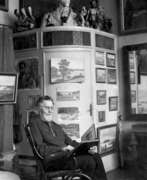

Antanas Žmuidzinavičius was a Lithuanian painter and art collector, celebrated for his significant contributions to Lithuanian art and culture. Educated at the Veiveriai Teachers' Seminary, he initially worked as a teacher while advancing his art education in Warsaw. Žmuidzinavičius's passion for art led him to Paris, where he studied at prestigious institutions such as the Académie Colarossi, enhancing his painting and drawing skills.
During World War I and the interwar period, Žmuidzinavičius played an instrumental role in safeguarding Lithuanian art and culture. He was a pivotal figure in organizing art exhibitions, and he dedicated considerable efforts to the collection and preservation of artworks amid political turmoil. His commitment to art extended beyond creation; he was deeply involved in education, teaching drawing at the Kaunas Art School and influencing generations of artists.
One of Žmuidzinavičius's most enduring legacies is the Devils Museum in Kaunas, a unique institution dedicated to sculptures and carvings of devils from around the world. The museum, which started with Žmuidzinavičius's collection, has grown to house over 3,000 items, reflecting a wide range of cultural perspectives on the devil. This museum not only showcases Žmuidzinavičius's fascination with folklore and mythology but also serves as a testament to his broad interests and contributions to Lithuanian heritage.
Antanas Žmuidzinavičius's work and his Devils Museum continue to captivate visitors, offering insights into Lithuanian culture, history, and art. For those intrigued by his life, contributions, and the unique devil collection, the Devils Museum in Kaunas is a must-visit, embodying the spirit of one of Lithuania's most notable artists.
For collectors and experts in art and antiques, the legacy of Antanas Žmuidzinavičius provides a fascinating glimpse into the rich cultural tapestry of Lithuania. Sign up for updates to stay informed on new product sales and auction events related to the incredible work of Antanas Žmuidzinavičius and to explore the depth of Lithuanian art and history further.
